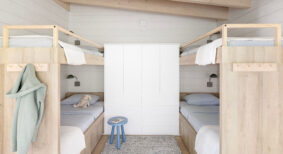Situated below the cliffs that edge the University of British Columbia (UBC) endowment lands and forming part of Pacific Spirit Park, Wreck Beach feels like it is on the edge of the world. Access to the beach is only possible by braving a steep 473 step log staircase that quickly removes any visitor from the sounds of campus life and traffic. It is an experience that belies entirely its proximity to downtown Vancouver. Indeed, this is no ordinary beach – it is Canada’s most famous nude beach.
Bruce Carscadden Architect was selected by Metro Vancouver to develop a strategy and design for permanent beach toilets to replace the beach’s long problematic plastic urinals and temporary toilet facilities. The design brief called for a solution that balanced the need for more comprehensive and accessible sanitary facilities that addressed the deceptively remote and unique socio-cultural aspects of both the site and its users – users who maintain a strong connection to Vancouver’s legacy of activism and political engagement.
Together with stakeholders, the design team identified the site’s remoteness and natural setting as central drivers of the project’s design and the requirement that any new facility not be visually or physically obtrusive and not create a target for bad behaviour.
Durable design
The toilets are located at the most popular section of the beach, near the foot of Trail 6, where the sand starts suddenly at the edge of the heavily forested cliffs and the beach has amassed a collection of logs loosened from offshore booms, rendering a reminder of Vancouver’s history and continued tradition in forestry. Wreck Beach makes for a strange bedfellow, of course, and once they reach the beach, the logs take on an entirely new purpose, serving as a place to lounge or dry a towel. Still, others are propped – inexplicably, mysteriously – vertically in the sand like trees or friendly totemic sentries.
It was in this image and narrative of an enigmatic collection of logs reimagined and reanimated to other ends that the design team, client and stakeholders found meaning: that the new facilities might occupy a similar place in the minds of visitors, even as they satisfied the more prosaic requirements of actual washrooms. The specific design resolution employs a collection of metal rounds of varying dimension clustered on a sandy dais at the edge of the forest – an obvious reference to the forest trees, vertical beach logs, and other abandoned naval and logging artifacts washed ashore over decades.
The cylindrical metal pipes vary in diameter and height with purpose, some for structural need, others to provide privacy screen and still others to provide venting for the gases created in the pit-toilet proper. The painted metal is easy to maintain and difficult to destroy.
Each of the four washrooms is a stand-alone pit toilet and circular in plan – a clever device to maximize privacy while eliminating corners to hide behind and produce the illusion of a facility smaller than it is. The shape is also the direct result of the location and means of construction; with all construction materials needing to be brought in by barge, efficiency was key, and the toilets sit on pre-cast concrete rings that form both the foundations and lids to the tank below.
The result is a collection of durable and deceptively modern suite of washroom facilities that sit comfortably back from the water at the threshold of the beach from the forest, deferring to the iconic and spectacular view while simultaneously reminding beachgoers of it as they open the door having finished their business.
Ian Ross McDonald is a partner at Bruce Carscadden Architect, a design studio based in Vancouver. His work with the firm includes the award-winning Swalwell Park, Kensington Park and Robert Burnaby Park washrooms.







